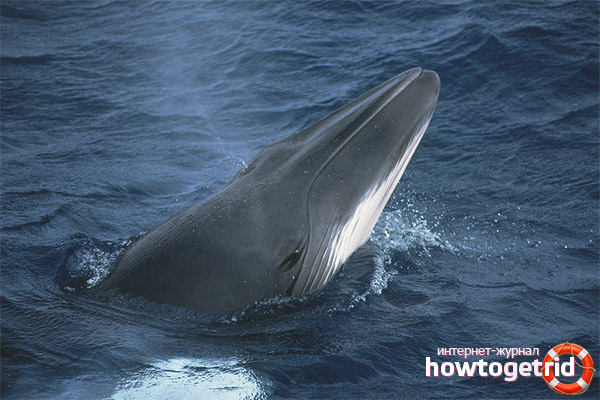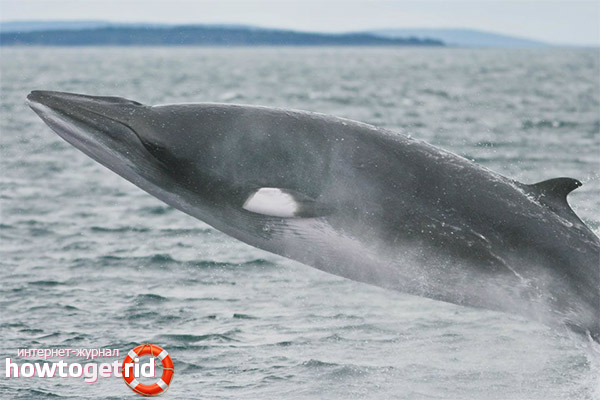The content of the article
The cetacean family is quite extensive and includes about 40 genera, which include 80 species. With all the differences, they have one thing in common - impressive size. Minke whale is the smallest and most common member of the family. The species is divided into three subspecies: dwarf, northern and southern (it is also Antarctic).
Description
Females are slightly larger than males, on average they have a length of 7.5 meters, large specimens reach 10 meters.
The males have a length of 6.9-7.1 meters, the maximum is 9-9.9 meters. The average weight of minke whales is 5-6 tons; in some specimens it reaches 14-15 tons. If compared with a blue whale weighing more than one hundred tons, the minke whale is the owner of a very modest size.
The back is black or dark shades, the belly is light. In whales living in the north, the fin is decorated with a white stripe, thanks to which the animal is easily identified. The inhabitants of the southern seas do not have such a strip. The dorsal fin is curved in the shape of a hook.
The whale is yellow in color; it differs in saturation in different subspecies - in some light shades, in others - darker. It grows on both sides of the mouth, counting from 240 to 360 plates.
Habitat
Behavior
Minke whales live in groups of two to four. But they can lead a purely solitary lifestyle. Although in places where fish walks and a lot of food, a large whale flock is formed. Dive into the water for 5-10 minutes, but can last at a depth and longer - up to 20 minutes. The small size allows the whale to move at a good speed - easily develops 40 kilometers per hour. Emerging, large water fountains are released, and with them a not very pleasant smell comes out, by which the presence of this whale can be identified.
Often hunting and getting food, animals swim in the passages that left the icebergs and find themselves imprisoned in ice for the winter. One has to live in ice captivity before the onset of the relatively warm season.
Stripes do not adhere to any particular territories, but travel a lot. Moreover, in attempts to study the world’s depths or chasing prey, they can swim to the other end of the Earth. There are cases when the southern minke whales that live in the Antarctic region often reached the northern seas and ended up off the coast of Greenland and Alaska.
Northern whales, in turn, climb far south. Once, one indefatigable inhabitant of the northern seas was found in the Amazon.
Preference is given to more temperate reservoirs than tropical. That is, it floats either in the northern seas, or near Australia and Antarctica.
Food

The diet of minke whale consists for the most part of not very large fish, krill, plankton and cephalopods - it depends on the region of habitat and the time of year. For example, the inhabitants of the northern hemisphere with pleasure eat small fish such as capelin, cod or horse mackerel, and those living in Antarctic waters have to be content with krill. Whales feed mainly in the morning or evening hours. The daily norm of food is from 3.5 to 5 percent of the total body weight. That is, from 150 to 200 kilograms.
Reproduction and development
Pregnancy lasts 310-330 days, one cub is born. The length of the newborn is about three meters, and the weight is more than 400 kilograms. Mother feeds him milk for five to six months, during which time he grows up strongly and becomes five-meter high. Then the growth is slower, by one and a half years the males grow to 6 meters, the females to 7.6.
Economic value
The number of minke whales in the oceans is quite large - about three hundred thousand individuals. He is not very popular with whalers. Nevertheless, there is a certain rate of production, it is about a thousand copies per year. Most whales are used for scientific research purposes. Some are sold in the markets.










Submit